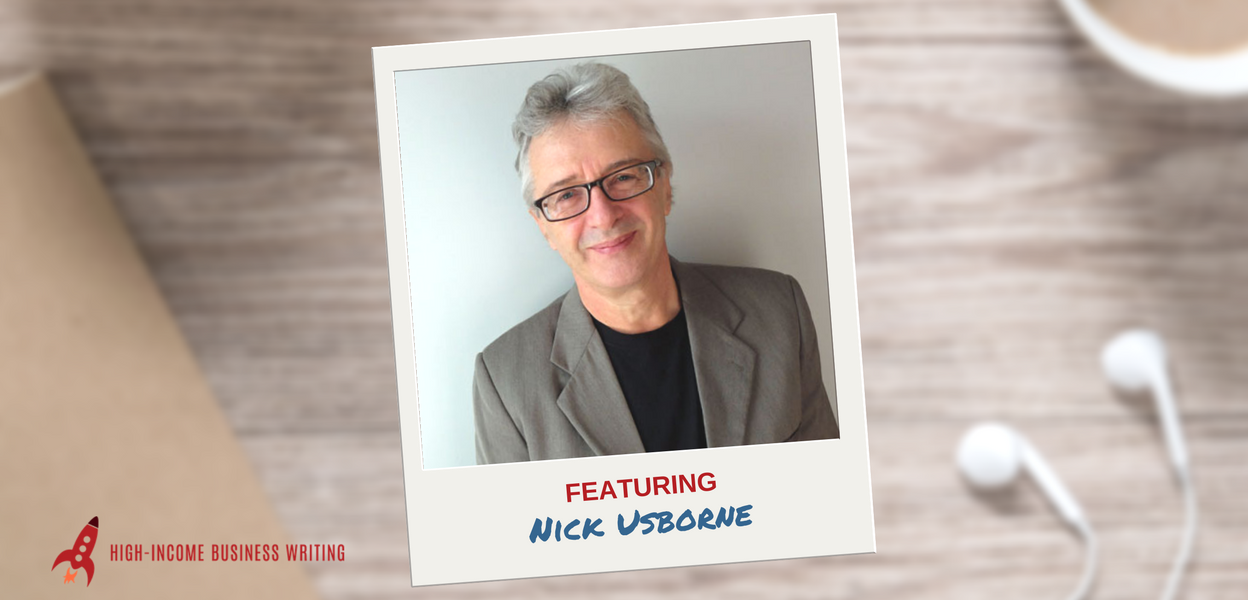I recently had Joanna Wiebe on the show to talk about writing copy that better connects with your audience.
And today we’re continuing that conversation with my colleague Nick Usborne.
Nick has written copy for some of the world’s biggest brands, including Citibank, Apple, Chrysler, MSN.com, New York Times, WebEx, the U.S. Navy and others.
So, yeah. He’s the real deal. And he attributes much of his success to a copywriting approach he recently defined as “conversational copywriting.”
It’s not what you think. This goes beyond the “write like you talk” advice we’ve all learned in copywriting books and courses.
In this chat, Nick explains what this approach is all about … and how you can adopt it to write more persuasive and effective copy for clients.
The notes that follow are a very basic, unedited summary of the show. There’s a lot more detail in the audio version. You can listen to the show using the audio player below. Or you can subscribe in iTunes to get this show delivered straight to the Podcasts app on your smart phone, tablet or iPod.


High-Income Business Writing with Ed Gandia
#145: Conversational Copywriting with Nick Usborne
How did you get started in copywriting?
As a young man, Nick Usborne shared a house in London with some friends while looking for a job. One of the friends worked in advertising. Nick wrote to 20 ad agencies and got a job offer. He’s been working in advertising ever since.
At first, his ad agency didn’t know what to do with him. Finally, they moved him to creative. He discovered he loved copywriting and was good at it. He’s now been writing copy for 18 years.
What’s your favorite type of copywriting project?
Nick prefers bigger projects. He likes building longer-term relationships with clients where he can immerse himself deeply into a project.
You talk about the idea of “conversational copywriting.” What is it and why is it so important today?
Before the web, media was a broadcast medium. It was about pushing out a message and interrupting people when they’re watching a show, listening to the radio, reading an article, etc.
Because you’re interrupting people, you have to be loud and push hard.
But the web different. It’s a multi-direction medium. It’s more conversational. When a company steps into a conversation online and applies old-style broadcast methods, listeners don’t like it. That’s why people are installing ad blockers in their browsers and filters on their email. They don’t like to be interrupted online.
What you want to do instead is join the conversation. You need to be respectful. You want to enter the conversation without interrupting.
If you can do this well, you’ll engage with people. And when you engage with them, they’re more likely to buy, buy again and recommend your product to friends.
Conversational copywriting is about mindset. It’s not just about how you write but what you write.
How can we write more conversational copy?
1. Become a better listener
Old school copywriting isn’t about listening—but conversational copywriting is.
Immerse yourself in the conversation. What terms are your audience using?
2. Think about how you communicate
What’s your mindset when you communicate? Are you trying to convince someone to change their beliefs? Or are you trying to engage in a conversation and share what you have to offer?
In B2C, think of how would you speak to that prospect over the kitchen table. You would listen. You wouldn’t use business jargon.
In B2B, think of how would you persuade people in a meeting. What would you say?
3. Let go of old habits
Many of us learned to write in school. But academic writing isn’t conversational. And business writing can be full of jargon. You need to let go of those old habits.
If you’re not sure how to do this, check out conversations on social media. How do people talk about your business and products? What language do they use? What’s important to them?
4. Think like a brand ambassador
It’s impossible for businesses to have a conversational tone because businesses don’t talk. It’s people within businesses that talk.
So try thinking like a brand ambassador.
You can’t engage customers by shouting at them. You need to listen to them.
Have you ever tried changing your physical environment when writing to make copy more conversational?
Sometimes getting away from your desk can help. By changing your environment, such as biking or driving, you can figure out what you need to say more elegantly. It shifts the focus from making a sale to having a conversation.
Reading your copy out loud is also very helpful. You’ll discover passages that sound awkward.
How does conversational copy impact SEO? Or does it even matter?
We’re quickly approaching the point where over 50% of searches are being done by voice.
People are speaking (instead of typing) their search inquiries via Siri, Google Assistant, Alexa, etc.
But your collection of keyword phrases is based on typed search terms. But typed search phrases tend to be abbreviated, e.g. “cheap vacation Cancun.”
But when we search via voice, we tend to speak in full sentences, e.g. “Hey Siri, can you help me find some cheap vacations in Cancun?”
Thus, pages that are written in a conversational language are a better match with voice search optimization.
How do you deal with clients who worry the copy is too casual?
You need to have this conversation before you write the copy. Talk to them about the benefits of conversational copywriting. Find out how comfortable they are with it.
Few (if any) clients will be willing to go “all in” on conversational copy from the get-go.
It’s better to implement it slowly. Start with social media because that’s already conversational. After that, roll it out to email because it’s already personalized and more conversational.
If the client is nervous, you can’t force them. But start slow and see how it goes.
As part of this rollout process, you’ll discover what a brand’s conversational voice sounds like—and that’s of great value.
Tell us about your new course on conversational copywriting
Nick has a video-based course on conversational copywriting. It consists of 21 different lectures with homework assignments. It also has a private Facebook group.
The course will teach you how to change your mindset to write emails, web pages, social media, etc. in a conversational tone that actually works.
Learn more about the course at Conversationalcopywriting.com.
Where can listeners connect with you online?
Nick’s site: Nickusborne.com. There, you’ll find links to his social media channels.
You can also email him at nick at nickusborne dot com.
By the way … whenever you’re ready, here are 4 ways I can help you grow your freelance business:
1. Grab a free copy of my training class for writers who are new to freelancing.
It’s called “The 3 Magic Levers: How to Get Your Writing Business Off the Ground and Land Your First Paying Client.” — Click Here
2. Download a free copy of my book for ESTABLISHED writers/copywriters.
You’ll discover how to quickly and predictably reawaken dead leads, generate new client opportunities and convert not-yet-ready prospects into freelance writing clients. — Click Here
3. Join our “Get Better Clients Academy”
You’ll get a personalized action plan based on where you are today in your business. Plus all the tools, scripts, checklists, cheat sheets and templates you’ll need to escape feast-or-famine … grow your income … and land clients who love and respect you. — Click Here
4. Get your website DONE!
If you’ve been struggling to get your website done … or if you’re not happy with what you’ve got today… let my team and I build you a beautiful website for your writing business. We’ll do all the hard work! Email me at ed@b2blauncher.com … put “WEBSITE” in the subject line … and I’ll reply with the details.






